Museum goes whole hog
Published 10:36 pm Tuesday, April 23, 2013
Ever wondered how the town of Smithfield became synonymous with ham? Find out during a free talk at Isle of Wight County Museum this Sunday.
Tracey Neikirk, the museum’s curator and registrar since 2007, will recount Smithfield’s connection to ham dating from the 1600s.

P.D. Gwaltney Jr., pictured with a 1902 ham, will be one of the characters discussed during a free talk at Isle of Wight County Museum Sunday.
“I’ve been researching the topic since I started” at the museum, said Neikirk, who holds a Bachelor of Arts degree in history.
“We will be covering different ham companies that were in Suffolk, using artifacts.”
Bermuda-born Capt. Mallory Todd, who lived in the town beginning in 1767, is credited with creating the first business curing and shipping Smithfield hams.
There were about five such Smithfield companies in the town’s ham heyday, according to Neikirk. “They were sold back and forth,” she said, adding other smaller companies never survived very long.
The two main artifacts Neikirk will incorporate in her talk are the museum’s largest ham, weighing in at 65 pounds and cured in 1955, and its oldest ham, cured in 1902.
Neikirk will also explore the connection between pork and peanuts.
In 1926, the Virginia General Assembly passed a law defining Smithfield ham as “cut from the carcasses of peanut-fed hogs, raised in the peanut belt of the Commonwealth of Virginia or the State of North Carolina, and which are cured, treated, smoked, and processed in the town of Smithfield, in the Commonwealth of Virginia,” according to Neikirk.
It was “kind of standard practice” among farmers in Isle of Wight and surrounding counties to let hogs forage in fields after harvesting peanuts, Neikirk explained.
“It kind of gave the meat a peanut flavor,” she said. ‘That’s why they wanted it to be called Smithfield ham. With political pull in the Virginia legislature, they were able to get that passed.”
The peanut part was removed in 1966, after Smithfield’s curing and shipping industry had grown to such an extent that hogs were being sourced from beyond peanut areas to keep up supplies.
“I have not tasted that ham,” Neikirk said of the peanut-infused variety. But she recalled a familiar smell that once wafted from the 65-pound ham as it warmed to room temperature after being removed from cold storage for an exhibit.
“It smelled like peanut butter,” she said.
The museum is at 103 Main St., Smithfield, and the walk-in event is free.
For more information, contact the museum at 356-1223 or visit www.historicisleofwight.com.






